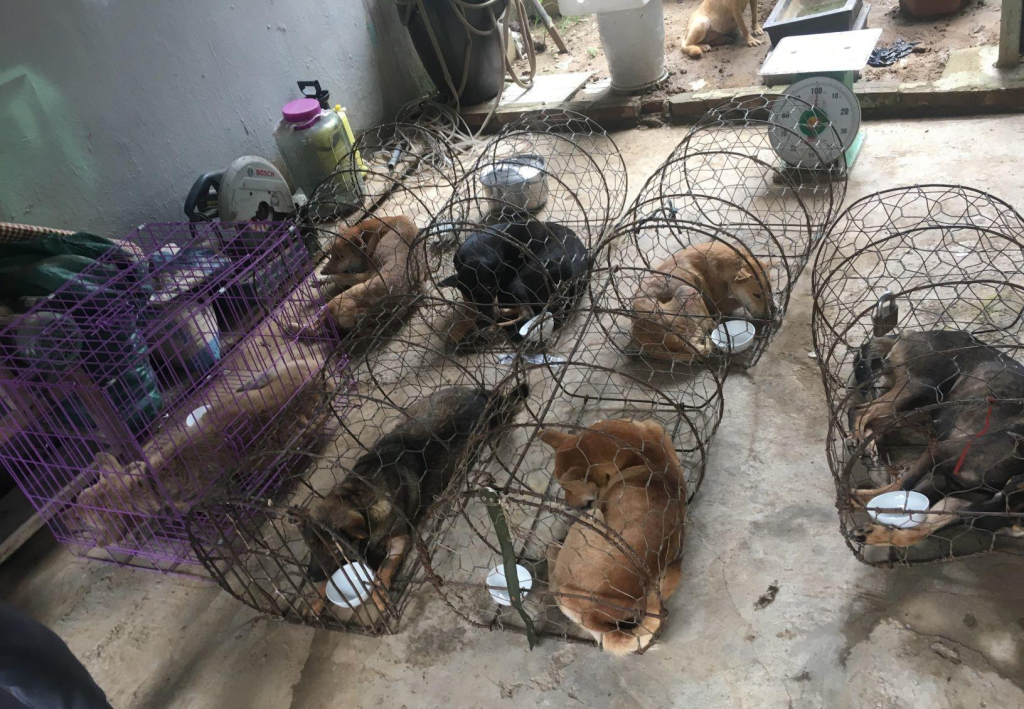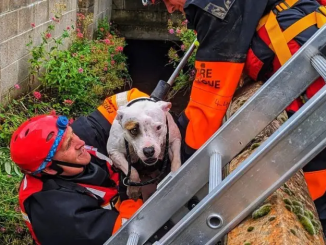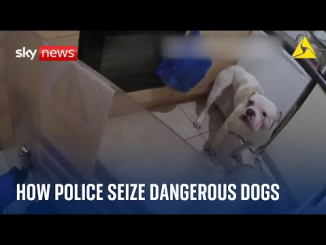
“An Incredible Tale of Survival: Man’s Best Friend Comes to the Rescue

In the breathtaking peaks of Croatia’s Velebit mountain range, Grga Brkić faced a life-threatening situation. While hiking on one of the highest peaks, he tragically fell 500 feet, fracturing his leg, rendering him immobile, and staring death in the face.
There’s a profound love that dogs have for us, a love that knows no bounds. One man who experienced this love firsthand is Grga Brkić. As he lay stranded in the freezing cold, with hypothermia creeping in, hope arrived in the form of his loyal companion, North—an eight-month-old Alaskan Malamute.
North, instinctively understanding the dire circumstances, climbed atop his injured owner, providing warmth and comfort until help could reach them. This harrowing incident unfolded approximately 5,800 feet above Croatia’s Adriatic coastline, as reported by PEOPLE.

Brkić’s fall left him with a fractured lower leg and the inability to move. Two fellow hikers discovered him and his faithful dog at the base of the slope, realizing the impossibility of lifting him out on their own. They immediately called for rescuers.
In an incredible display of loyalty, North nestled beside Brkić, sharing his body heat to keep him warm. Alaskan Malamutes are known for their remarkable cold tolerance, capable of withstanding temperatures as low as -20°F, thanks to their thick, waterproof double coats designed for the harsh Arctic conditions.

For 13 grueling hours, Brkić clung to hope, knowing that North was his lifeline. Finally, a team of 27 first responders from the Croatian emergency mountaineers, Hrvatska Gorska Služba Spašavanja, arrived on the scene, and their astonishment was palpable. North had steadfastly curled around Brkić, providing vital warmth throughout the ordeal.
The rescue mission faced daunting challenges—snow, ice, and fallen trees—making it one of the most demanding operations ever undertaken by these seasoned professionals. Remarkably, North never left Brkić’s side.
Ultimately, they were airlifted to a nearby hospital, where Brkić underwent a lifesaving emergency operation, making a full recovery. Thankfully, North emerged from the incident unscathed.
Josip Brozičević, the head of the Croatian mountain rescue services, praised North’s heroic actions, stating, “The dog was curled up next to the owner in the pit the entire time; he warmed his owner with his body, thus preventing the mountaineer’s significant hypothermia who suffered a severe fracture of the lower leg and ankle when he fell.”

In a heartfelt interview with Croatian media, Brkić expressed his gratitude, acknowledging that he wouldn’t be alive today if it weren’t for North. The moments before rescue arrived felt agonizingly slow, but North’s presence was a true miracle.
Following the incident, the Croatian emergency mountaineers posted about the incredible rescue, and Brkić’s family shared an update, confirming that both he and North were doing remarkably well.
This extraordinary tale is a testament to the indomitable spirit of friendship between humans and their loyal canine companions. Share this story to celebrate the extraordinary bond between Grga Brkić and North and to honor the incredible bravery of our furry friends.
In the breathtaking peaks of Croatia’s Velebit mountain range, Grga Brkić faced a life-threatening situation. While hiking on one of the highest peaks, he tragically fell 500 feet, fracturing his leg, rendering him immobile, and staring death in the face.
There’s a profound love that dogs have for us, a love that knows no bounds. One man who experienced this love firsthand is Grga Brkić. As he lay stranded in the freezing cold, with hypothermia creeping in, hope arrived in the form of his loyal companion, North—an eight-month-old Alaskan Malamute.
North, instinctively understanding the dire circumstances, climbed atop his injured owner, providing warmth and comfort until help could reach them. This harrowing incident unfolded approximately 5,800 feet above Croatia’s Adriatic coastline, as reported by PEOPLE.
Brkić’s fall left him with a fractured lower leg and the inability to move. Two fellow hikers discovered him and his faithful dog at the base of the slope, realizing the impossibility of lifting him out on their own. They immediately called for rescuers.
In an incredible display of loyalty, North nestled beside Brkić, sharing his body heat to keep him warm. Alaskan Malamutes are known for their remarkable cold tolerance, capable of withstanding temperatures as low as -20°F, thanks to their thick, waterproof double coats designed for the harsh Arctic conditions.
For 13 grueling hours, Brkić clung to hope, knowing that North was his lifeline. Finally, a team of 27 first responders from the Croatian emergency mountaineers, Hrvatska Gorska Služba Spašavanja, arrived on the scene, and their astonishment was palpable. North had steadfastly curled around Brkić, providing vital warmth throughout the ordeal.
The rescue mission faced daunting challenges—snow, ice, and fallen trees—making it one of the most demanding operations ever undertaken by these seasoned professionals. Remarkably, North never left Brkić’s side.
Ultimately, they were airlifted to a nearby hospital, where Brkić underwent a lifesaving emergency operation, making a full recovery. Thankfully, North emerged from the incident unscathed.
Josip Brozičević, the head of the Croatian mountain rescue services, praised North’s heroic actions, stating, “The dog was curled up next to the owner in the pit the entire time; he warmed his owner with his body, thus preventing the mountaineer’s significant hypothermia who suffered a severe fracture of the lower leg and ankle when he fell.”
In a heartfelt interview with Croatian media, Brkić expressed his gratitude, acknowledging that he wouldn’t be alive today if it weren’t for North. The moments before rescue arrived felt agonizingly slow, but North’s presence was a true miracle.
Following the incident, the Croatian emergency mountaineers posted about the incredible rescue, and Brkić’s family shared an update, confirming that both he and North were doing remarkably well.
This extraordinary tale is a testament to the indomitable spirit of friendship between humans and their loyal canine companions. Share this story to celebrate the extraordinary bond between Grga Brkić and North and to honor the incredible bravery of our furry friends.
51 DOGS RESCUED FROM THE DOG MEAT TRADE IN VIETNAM

Dr. Katherine Polak, Head of Stray Animal Care Southeast Asia for FOUR PAWS
The dog meat trade is big business in Vietnam and threatens the lives of millions of dogs every year, many of them pets. Every day, pets are violently snatched off the streets, from yards, and even while out on a walk with their owners. These unlucky dogs make a brutal journey to slaughterhouses, markets, and restaurants, where a gruesome death awaits them. But times are changing, and the brutality and illegality of pet theft is no longer being tolerated by Vietnamese authorities.
In a landmark case, police in Thanh Hoa Province received a tip off regarding a gang of dog thieves believed to have stolen thousands of dogs since the beginning of the year. On September 15, 2019 the police successfully carried out the largest ever bust of a dog theft ring in Vietnam, resulting in the seizure of 51 dogs. According to the police, the gang carried stun guns and other sharp weapons, and rode motorbikes through residential areas late at night shooting dogs roaming outside. Police arrested a total of 16 suspected gang members and questioned more than 40 suspects. The gang not only brutalized neighborhood dogs, but also caused outrage among local people, particularly pet owners.
Following the interception, Police struggled to properly care for the confiscated dogs given their limited capacity for animal care, so the Asia Canine Protection Alliance (ACPA), of which FOUR PAWS is a member, stepped in to offer assistance. There were 13 dogs in need of immediate medical care due to severe wounds sustained during capture. Dogs with painful open wounds were anaesthetised, treated, provided pain medication and antibiotics, and housed in a temporary shelter for ongoing treatment.
The Asia Canine Protection Alliance is an international alliance of four animal protection organizations committed to ending the illegal trade of dogs in Vietnam: FOUR PAWS, Animals Asia, Humane Society International, and Change for Animals Foundation. ACPA is working to build collaborative relationships with the governments throughout Southeast Asia where the dog meat trade is prevalent, and has already secured a moratorium on the trade in dogs between Thailand and Vietnam.
Following the confiscation, the police publicised the bust throughout the province using local media so that stolen dogs could be reunited with their families.
Over the course of 2 weeks, all 51 dogs were successful reunited with their owners, who were devastated by their pets’ disappearance.
This bust pets a major precedent as dog theft is rarely treated as a criminal offense in Vietnam unless the canines are valued at more than VND2 million ($86).
“These arrests will hopefully go a long way in deterring future dog theft in Thanh Hoa Province, and potentially throughout all of Vietnam. While the dog meat trade is often defended as ‘culture’ or ‘tradition’, the reality is that there are significant health and societal impacts associated with the trade and these are becoming of ever-growing concern within Vietnam and internationally.”

Earlier in the week, the Food Safety Management Board of Ho Chi Minh City urged locals to stop eating dog meat in an effort to improve Vietnam’s national image with tourists. They also warned the local community of the health risks posed by consuming the unregulated meat. This followed a similar call by the Hanoi People’s Committee last year.
In addition to membership in ACPA, FOUR PAWS also runs a ‘Cats Matter Too program‘ in Central Vietnam with local charities PAWS for Compassion and Vietnam Cat Welfare to improve veterinary training, animal welfare education, and provide free spay/neuter services.



Leave a Reply